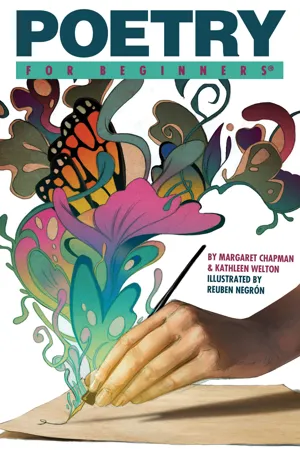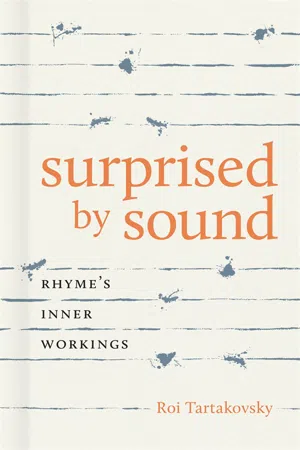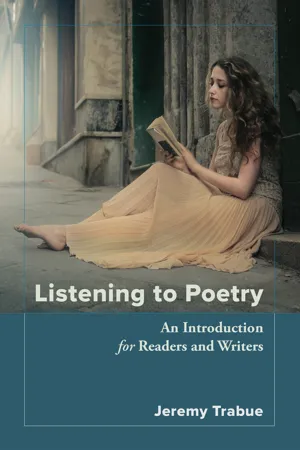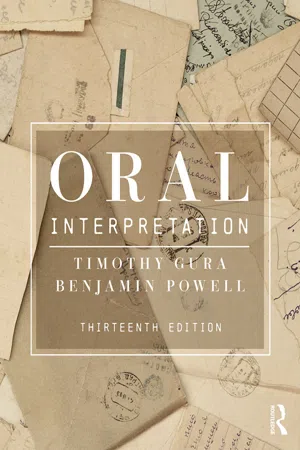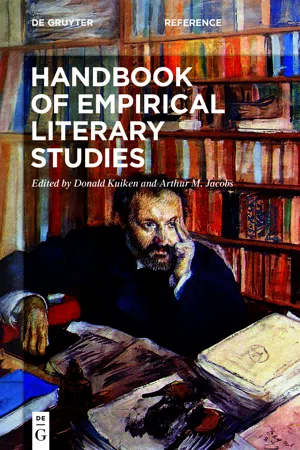Literature
Rhyme Scheme
Rhyme scheme refers to the pattern of rhymes at the end of each line in a poem or song. It is typically represented using letters to indicate which lines rhyme with each other. For example, a common rhyme scheme in a quatrain might be ABAB, indicating that the first and third lines rhyme with each other, and the second and fourth lines rhyme with each other.
Written by Perlego with AI-assistance
Related key terms
8 Key excerpts on "Rhyme Scheme"
- eBook - ePub
- Margaret Chapman, Kathleen Welton, Reuben Negrón(Authors)
- 2010(Publication Date)
- For Beginners(Publisher)
internal rhyme.Probably the most common sort of Rhyme Scheme is when two rhyming lines are right next to each other. These are called rhyming couplets.Here's an example, “Song of the Witches,” from Shakespeare's Macbeth, (which is a play full of poetry):Double, double toil and trouble; A Fire burn and caldron bubble. A Fillet of a fenny snake, B In the caldron boil and bake; B Eye of newt and toe of frog, C Wool of bat and tongue of dog, C Adder's fork and blind-worm's sting, D Lizard's leg and howlet's wing, D For a charm of powerful trouble, E Like a hell-broth boil and bubble. ESo every two lines rhyme together in pairs. If you were discussing this Rhyme Scheme, you would probably just call it an AABB scheme—you sort of get the point after the first few couplets. In this section there is a ton of end rhyme, but also some internal rhyme, especially in that first line.If you haven't already, try reading this section from Macbeth out loud. Notice anything? You might notice the repetition—there is a load of alliteration in these few lines. You may also notice that the words seem a little sing-songy? Maybe you find yourself reading to a certain beat?Can you hear the rhythm in the poem?Let's talk about that. Rhythm in poetry can come from repetition, like anaphora or alliteration, or from something called meter. Meter is a pattern of stressed and unstressed syllables in poetry which is constant throughout a number of lines, or an entire poem.All words have syllables that are either stressed or unstressed. Think of the word “syllables.” We pronounce it SYLL-a-bles. It would sound weird if we pronounced it syll-A-bles. When we are looking at meter in poems, we look for two or three syllable patterns which are repeated. These are called feet. - eBook - ePub
The Princeton Encyclopedia of Poetry and Poetics
Fourth Edition
- Stephen Cushman, Clare Cavanagh, Jahan Ramazani, Paul Rouzer, Stephen Cushman, Clare Cavanagh, Jahan Ramazani, Paul Rouzer(Authors)
- 2012(Publication Date)
- Princeton University Press(Publisher)
This is one of the chief pleasures of formal verse (see STANZA). Rhyme Schemes also reveal links with identical kinds of order in other domains such as rhet. or meter. The scheme for the Petrarchan sonnet, e.g., is abbaabba cdecde, i.e., an octave of two sets of envelope rhyme followed by a sestet of two tercets whose rhyme is repeated seriatim. The orders here are *envelope—a scheme of repetition in reverse—and sequence—repetition in order. Normally, rhymed stanzas contain rhymes that have at least one mate inside the same stanza; other less common but still important elements of order in rhyming are monorhyme, i.e., iteration of the same rhyme sound (as in OF assonance or triplets in couplet verse); lines whose rhyme is indeterminate or optional in the midst of other lines with obligatory participation in the Rhyme Scheme (marked with an x in the Rhyme Scheme); “isolated rhyme” or “thorn rhymes” (Occitan rim estramp, Ger. Korn —see CLAVIS); lines that have a mate only in following stanzas; and rhymeless lines without mates anywhere in the poem (Ger. Waise, “orphan” lines; more exploited in Rus.). All these devices structure the aesthetic space either by adding higher levels of order or by opening up spaces within the order for some amount of free play. (12) By sight versus sound. In most poetry of all ages and langs., sound is the primary stratum, and rhymes are based on sound correspondence; strictly speaking, the spelling of words is irrelevant. Furthermore, spelling can mislead inattentive readers if they respond to the visual shape of the words instead of the aural. Still, this is a narrow view, and it is undeniable that literate poets of all ages have been aware to some degree of the visual dimension of poetry (Hollander’s “poem in the eye”). The relations of sound to orthography in a given lang. are more manifold than is usually supposed, and these must be attended to - No longer available |Learn more
- George Ehrenhaft(Author)
- 2023(Publication Date)
- Barrons Educational Services(Publisher)
seen/been; ill/all; summer/somewhere). A major function of slant rhymes is to help avoid the monotony of repetitious conventional rhyme. The slant offers a change of pace, a small but welcome deviation, as in the concluding lines of this fragment from F. T. Prince’s “To a Friend on His Marriage”:A beautiful girl said something in your praise. And either because in a hundred waysI had heard of her great worth and had no doubtTo find her lovelier than I thoughtAnd found her also cleverer, or becauseAlthough she had known you well it was . . .Sometimes, an individual line of poetry contains two or more words that rhyme. Examples of such an internal rhyme are found in Tennyson’s “Blow, Bugle, Blow”:Poets may include internal rhymes for emphasis or additional unity. If used excessively, however, internal rhymes could create monotony rather than interest.The splendour falls on castle wallsAnd snowy summits old in story:The long light shakes across the lakesAnd the wild cataract leaps in glory.Rhyme Scheme
A Rhyme Scheme is the pattern of rhyming words within a given stanza or poem. For convenience, each similar end rhyme is usually identified with a letter of the alphabet, here illustrated by Francis Cornford’s “The Watch”:I wakened on my hot, hard bed, aUpon the pillow lay my head; aBeneath the pillow I could hear bMy little watch was ticking clear. bI thought the throbbing of it went cLike my continual discontent, cI thought it said in every tick: dI am so sick, so sick, so sick; dO death, come quick, come quick, come quick, dCome quick, come quick, come quick, come quick. dThis shorthand technique applies to rhymes in any poem. The Rhyme Scheme of “It’s No Use Raising a Shout” (page 99 ) is simply a-a-b-b-c-c; of “She Walks in Beauty” (page 100 ): a-b-a-b; and of “The Dying Airman” (page 100 ): a-b-c-b - eBook - ePub
Surprised by Sound
Rhyme's Inner Workings
- Roi Tartakovsky(Author)
- 2021(Publication Date)
- LSU Press(Publisher)
Reading any number of Alexander Pope’s long works in heroic couplets, one comes quickly to expect the rhyming pairs at the end of the line. Reading a Shakespear-ean sonnet, one knows or learns to expect where the rhymes will fall, the Rhyme Scheme scheming the logic of the entire sonnet, as is the case with Petrarchan and Spenserian sonnet forms and their respective Rhyme Schemes. The reading of the quatrains of Alfred, Lord Tennyson’s In Memoriam is accompanied by the recurrence of the envelope rhyme / abba /, just as the reading of Edward Fitzgerald’s translation of Rubaiyat, Omar Khayyam’s quatrains, is accompanied by the recurrence of the /aaxa/ scheme. Similarly, the reading of most realizations of what Derek Attridge (Rhythms of English Poetry) has called the “underlying four-beat rhythm” (nursery rhymes, ballads, hymns) is accompanied by the recurrence of /aabb/, /abab/, or /xaxa/ schemes. In each of these cases, and in so many others, rhyme is systematized, appearing at the end of the line and following a discernible, often predictable, often repeated, pattern. Either within the poem or within the genre or poetic form, rhyme recurs and is institutionalized. Already in 1589, George Puttenham is able not only to list different Rhyme Schemes but also to start assigning differential effects to each of them, one being “vulgar,” another “pleasant” (84–91). Rhyme’s systematic employment marks one of rhyme’s central functions, the schematic or organizational function—in Puttenham’s terms, “a band given to every verse in a staffe, so as none fall out alone or uncoupled,” like the band provided by a mason to fasten the bricks of a house (89). Even today, thinking about rhyme defaults to its systematic variant or schematic function: “rhyme” generally means end rhyme that one finds forming a discernible gestalt or Rhyme Scheme. Returning to the historical narrative, it is no less significant to note that the era of systematization was preceded by an era of sporadic use - eBook - ePub
Listening to Poetry
An Introduction for Readers and Writers
- Jeremy Trabue(Author)
- 2019(Publication Date)
- Chemeketa Press(Publisher)
Rhyme Schemes are also commonly used prescriptively, too, as part of describing a received form. For example, the Shakespearian sonnet is partially defined by conforming to the Rhyme Scheme ABAB / CDCD / EFEF / GG.Final Thoughts
Many poems tell interesting stories, but all poems are at least a little bit like a song. The musicality of language itself is the heart and soul of many poems. Hearing that music is central to understanding and appreciating them. The variety of sounds that words make can create a subtle music all by itself.The syllable is a basic unit of language, generally defined as the sound of a vowel and the consonants around it. In English, syllables can be accented or unaccented, and this basic feature of the language is something that poems can fashion into musical patterns. Rhyme, most broadly, is the repetition of ending sounds in words, usually at the ends of lines. Rhyme is fundamentally simple but also exists in many variations and can be created, manipulated, and mixed with other song elements in many ways.To finish off the chapter, here’s a list of reminders, tips, and tricks to help you as you work with musical language:• In dealing with any song element, read out loud, read out loud, read out loud. Then have someone read to you and listen with the poem in front of you and a pencil in your hand. There is no substitute for feeling the poem in your mouth and hearing it in another voice. Get help from a real human being, in person, if you can. This isn’t the easiest material to learn from the silent page.• Scribble all over the poems. It’s hard to keep track of all the individual pieces in your head while you try to figure out what kind of pattern they make. Making notes as you find the sounds allows the pattern to emerge naturally.• When analyzing syllables, use the dictionary to locate the syllable breaks and the stress patterns in multisyllabic words.• When listening for rhyme specifically, try reading, at least at first, only the last syllable of each line out loud. “Close enough” gen erally counts in rhyme. If you can reasonably imagine a word rhyming, let it rhyme. - eBook - ePub
- Timothy Gura, Benjamin Powell(Authors)
- 2018(Publication Date)
- Routledge(Publisher)
As is true of what you learn from scansion, what you discover from studying cadence has a direct input into your rehearsal. If, say, you choose to perform “Open the Gates” (by now, you know a great deal about how that poem works), you can embody and evoke this knowledge. Specifically, what rate will you select for the first stanza? Of course, your decisions about where to pause will be guided by what you discover in secondary cadences. Will you simply repeat the same choices in stanza 2? Why not? And, as you approach line 8, how will you negotiate the dangerous phrases in “I brandish the great bone of my death” so that you prepare listeners for “Beat once therewith, and beat no more”? The last two lines are the longest in the poem. Are they rushed to finish the poem off, or paced more deliberately to show the final, appalling sight that confronts the speaker? If you hadn’t discovered this in analysis, would you have intuitively made all the appropriate decisions in performing this poem? Analysis provides you with certain wisdom. In the tumult of anxieties that attends any performance, such certainty is a rock on which interpreters gladly rest.Clearly, no audience will ever grasp fully the subtlety of this rhythmic pattern when the poem is read aloud. Indeed, it would be most unfortunate if you called attention to the pattern. Nevertheless, unless you understand what the poet has done to communicate the total effect, your audience loses.Rhyme
Rhyme most commonly occurs at the line ends. Lines may contain internal rhymes as well. Unlike rhythm and cadence, rhyme is not an essential element of poetry—some fine poems have very little rhyme. But when it occurs it can reinforce rhythm, cadence, pattern, and tone color.Although corresponding sounds strike the mind’s ear in a silent reading, they emerge for complete appreciation only when a poem is read aloud. Like a chime of music, rhyme is satisfying and pleasing to hear; it gives intellectual pleasure through the delights of repetition and anticipation. The reason for rhyme, however, is not to decorate a poem but rather to bind it more closely together. For one thing, rhyme unifies the pattern of sound. Its power doubtless contributes to the explosive popularity of rap music and hip hop. Can you imagine either without rhyme? Just as in more traditional poetry, rhyme emphasizes the line lengths by creating an expectation of repeated sounds at regular intervals. Experienced poets and rap artists know that rhyme, if used unwisely, can shatter rather than intensify the unity of a poem. Therefore, when they use rhyme, they exhibit great care and ingenuity in handling it. It’s a powerful tool so you need to use it carefully. If you stress every rhyme, the aural shape of the poem blocks out all of its other qualities. Now for some more terms.Rhyme is the exact correspondence of both final vowel and consonant sounds (love—dove). There are several kinds of rhyme. Assonance is the correspondence of vowel sounds only, regardless of the final consonant sounds (place—brave). In half rhymes (pavement—gravely, river—weather - Editors of REA(Author)
- 2012(Publication Date)
- Research & Education Association(Publisher)
The most common is the end rhyme, which has the rhyming word at the end of the line, bringing the line to a definite stop but setting up for a rhyming word in another line later on, as in “Stanzas”: home… Rome, a perfect rhyme. Internal rhyme includes at least one rhyming word within the line, often for the purpose of speeding the rhythm or making it linger. Look at the effect of Byron’s internal rhymes mixed with half-rhymes: “combat… for that”; “Can/And… hanged” slowing the rhythm, making the reader dwell on the harsh long “a” sound, prolonging the sneer which almost becomes a snarl of anger. Slant rhyme, sometimes referred to as half, off, near, or approximate rhyme, often jolts a reader who expects a perfect rhyme; poets thus use such a rhyme to express disappointment or a deliberate let-down. Masculine rhyme uses one-syllable words or stresses the final syllable of polysyllabic words, giving the feeling of strength and impact. Feminine rhyme uses a rhyme of two or more syllables, the stress not falling upon the last syllable, giving a feeling of softness and lightness. One can see that these terms for rhyme were written in a less enlightened age! The terms themselves for the rhymes are less important than realizing or at least appreciating the effects of the rhymes. If the lines from “Stanzas” had been unrhymed and varying in metrical pattern, the verse would have been termed free, or to use the French term, “Vers libre,” not to be confused with blank verse, which is also unrhymed but has a strict rhythm. The Elizabethan poets Wyatt and Surrey introduced blank verse, which Shakespeare uses to such good effect in his plays, and later, Milton in the great English epic Paradise Lost. Free verse has become associated with “modern” poetry, often adding to its so-called obscurity because without rhyme and rhythm, poets often resort to complicated syntactical patterns, repeated phrases, awkward cadences, and parallelism- eBook - ePub
- Donald Kuiken, Arthur M. Jacobs(Authors)
- 2021(Publication Date)
- De Gruyter(Publisher)
The traditional Welsh poetic form cynghanedd features complex consonantal and stress patterns involving several words within a line of verse, e. g., “A d ae th i b en | d ei th io b yd.” Vaughan-Evans and colleagues (2016) studied the processing and evaluation of this poetic form, combining EEG during sentence reading with intuitive judgments about how “good” the sentences sounded. They observed a distinctive brain response associated with attentional re-orientation in the cynghanedd, but not in control conditions that violated one or both of the constraints on stress and consonantal re-occurrence; readers' conscious judgments, by contrast, did not distinguish between sentences that conformed to the constraints of the form and those that did not. Rhyme occurs if two words share the same sounds from their last prominent syllable onwards (see, e. g., Fabb, 1997); slight deviations from the strict identity constraint are conventionally licensed in many poetic traditions, and a few studies have examined the perception of such imperfect or slant rhymes (e. g., Knoop et al., 2019; Stausland Johnsen, 2011). The bulk of rhyme-related empirical research so far has examined end rhyme, i. e., the systematic use of rhyme to mark the closure of poetic structures such as (half-)lines of verse. This regular recurrence of identical vowel sounds makes rhyme both a rhythmic (Breen, 2018; Menninghaus et al., 2014) and a distinctly melodic element of verse, comparable to the return to the tonic in music (Lanz, 1926; Schramm, 1935a, 1935b). During text processing, systematic end rhyme allows one to predict upcoming input and facilitates word processing if the prediction is fulfilled (Menninghaus et al., 2014; Obermeier et al., 2016). Even during reading, the non-fulfillment of a prediction modulates brain responses as early as 150 ms after the onset of a non-rhyming word
Index pages curate the most relevant extracts from our library of academic textbooks. They’ve been created using an in-house natural language model (NLM), each adding context and meaning to key research topics.
